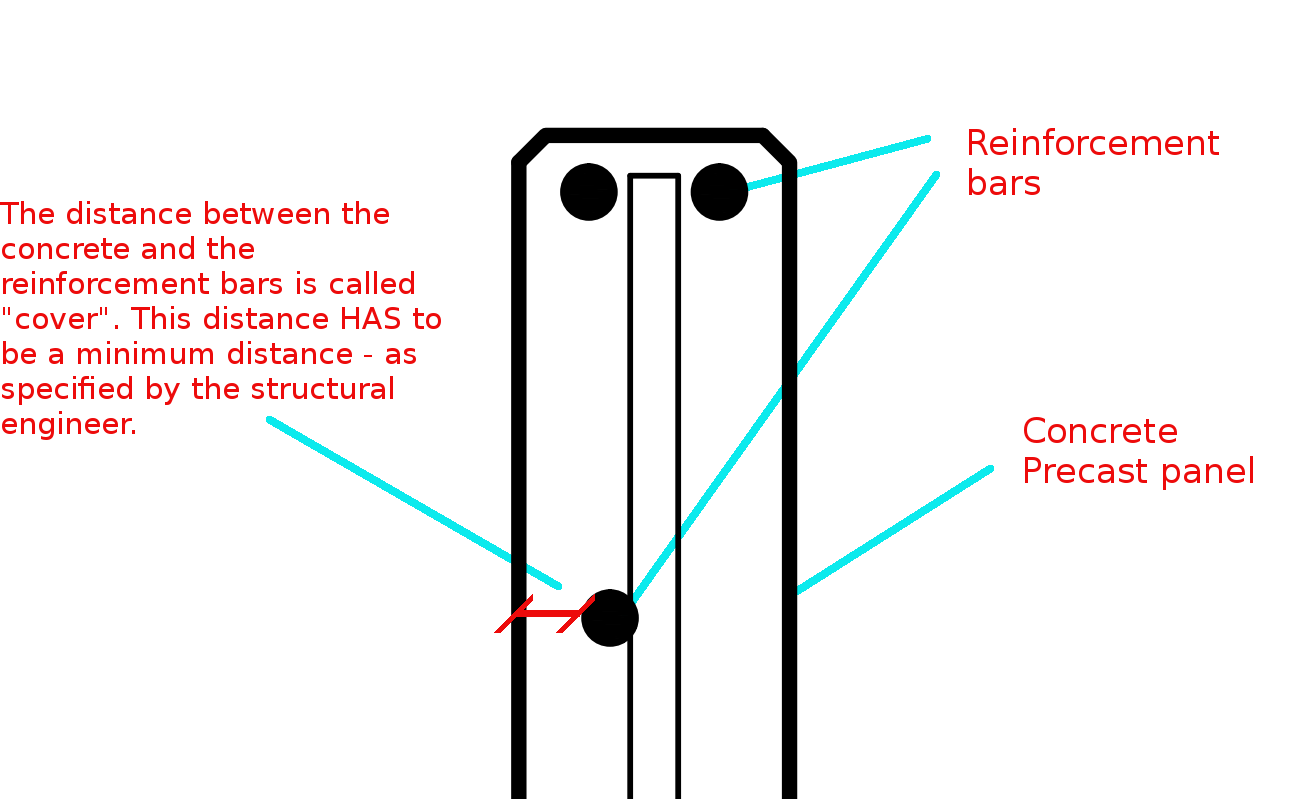What is concrete cover?
Cover refers to the distance between the outside of a concrete structure and the reinforcement. Perhaps see this from the diagram below:


You need to have a minimum cover:
There needs to be a minimal distance between the reinforcement bar and the outside of the panel.
Why do you need this?
Reduces Corrosion
- Having a decent amount of cover reduces the rate of the corrosion of those reinforcement bars. If you have only 5 mm of cover – if the bar is literally just below the surface of the concrete, then that reinforcement is going to corrode away very quickly – especially if you are close to the sea. This means that the concrete will lose its strength very quickly, and a catastrophic failure might be on the cards. That’s why it is very important that the concrete does indeed have some minimal cover.
To Improve the Structural Integrity of the Concrete:
- If you have the reinforcement bar too close to the concrete, then the structural integrity of the structure will be somewhat compromised.
Fire Protection:
- If at all there is a fire, you don’t want the reinforcement bars igniting. If it does then the fire is sure to blaze out of control. That’s another reason why it’s very important that the bars some minimal distance away from the surface of the concrete. That will better enable the structure to remain in tact if at all there is a fire.
A Response to a Reader’s Question:

“(Q1) It appears that one of the lapped bar is bent while the other isn’t. Or is it just a drawing convention problem?”
(Q2) I don’t get why the lapped bars have to be positioned differently when placed on the top vs at the bottom in order to ensure that the concrete thickness will not reduce, as stated in the figure. My thought is that both positioning ways occupy the same volume.
The answer to this question is best understood by studying the below diagrams:


The Answers to the Questions
(A1) When I draw reinforcement, I do not add a lot of the essential details which are assumed to be standard workshop practice. We are required to maintain a minimum cover. The diagram you have posted above is an example of what actually occurs in practice (but is almost never drawn that way). The reason it is bent is to ensure that the minimum cover requirements are not compromised.
(A2) That is absolutely correct – the panel’s thickness will not be reduced, but the thickness of the cover will change, depending on how one places the “reo” (reinforcement) rods.
Very nice and comprehensive explanation! It clears up my doubts. Thank you so much!
I now understand that by bending a reinforcement gives us an easy reference for maintaining the required cover distance. Yet, just one follow-up question-maybe a too detailed one-will bending the bars create some weak points in the bar so it becomes unsafe?
I also notice the fact that the lapped part will not be placed at locations with strong tension. So it helps avoid the problem?
Thank you again!
Best regards,
Ken
bending one reinforcement bar*
Hi Ken
pls see below:
(a1 )I’m not an expert on this question. My understanding is that cold bending can create some weak points – but that depends on how much you bend it: a small bend no problems. If you’re tying a ribbon/knot with reo then bending might be an issue. The guys on the construction site know this kinda of stuff.
(a2) That’s right – lapping should not occur in places with significant tension. The engineers don’t specify where exactly to lap in their drawings – the guys on site will know though.
regards
Koshy
Thank you so much!
Regards,
Ken
thnks indeed
Thanks for explaining!
very well written article. I am searching for these types of topics to read for a long time.